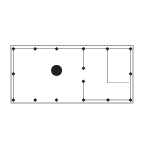Sensory Boundaries / Cognitive Geometries
The site of the parliament is a relentless free plan modified and ordered by painted markings, super-graphics and cognitive auras. Human perception of the site is the cognitive sum of sight, smell, and sound. Sight is immediate and favors the peripatetic subject. Human observers watch laboratory events from the mezzanine. Smell and sound are temporal. Smells can be diffuse and travel slowly. Sound travels quickly, but is the most prone to interference. Large areas of flexible space are interrupted by bands of human and non-human traffic. Laboratory materials are delivered by conveyor belts.
Open Source / Cognitive Shadows
The ground floor of the parliament is a mat laboratory condition. Laboratories represent imaginations of possible worlds whose boundaries are loosely delegated by painted floor markings. The flexible condition of the free plan results in conflicts that allow imaginations to move and shape one another. As delegations come and go, the composition of the ground floor changes to accommodate new research protocols and agendas.
Dialectical Section / Catalog of Actions
Knowledge produced by laboratories becomes a catalog of actions and protocols. The origin of knowledge and the point of transfer between production and discussion or dissemination is the column. Knowledge travels from lab to lab or from lab to discussion and back. Friction between transfer points are moments of convergence or divergence between imagined outcomes. Knowledge is sometimes additive. Knowledge paths collide and an imagination is reified and elaborated. Representations of knowledge are observed and interpreted by human and non-human subjects.
Morality Demonstrations / Projective Imaginaries
Demonstration produces the bulk of the images of fact. The building is a perceptual apparatus. Delegations construct the physical settings which test the boundaries of sensor fusion. The way humans see space and how nonhuman subjects see space are different, but here, are reconciled. The building is capable of adding additional richness to the perception of reality. Discussions about accident outcomes are aided by hybrid perceptual material. Autonomous vehicles are an abstraction of our value judgements, cognitive abilities and virtuosity. Discussing the decisions made by vehicles in events of sensor failure create a rupture in convention; a moment to reevaluate the role of objectivity in political discourse.
Copyright © 2018 Evio Isaac
Standards of
Diplomacy
Project Info
Collaborators: Keegan Hebert
Alina Plyusnina
Program: Parliament
Location: N/A
Year: 2017
The parliament’s general purpose is to apprehend regimes of cognition and perception of human and nonhuman subjectivities. It’s task is to deepen and intensify the relationship between human and nonhuman subjects, generating empathy between entities.
Two perceptual regimes coexist and are intertwined; imaginations of a possible future are reified, or validated. The parliament - a network of laboratories - synthesizes a constellation of scientific facts, translates and disseminates this knowledge.
The form of the parliament is such that phenomena can be enacted and represented in order for legislation to emerge as something secondary to the observation, demonstration, and ethical discussion/negotiation of fact. This format creates a rupture in political discourse that begins to reconcile the voice of science with the humanist biases of political rhetoric. In that way, politics (and by extension, science) might be rendered more capable of greater inclusivity by advocating for non-human subjectivities.
Studio Critics: Urtzi Grau,
Guillermo Fernandez-Abascal
Published: KoozArch
